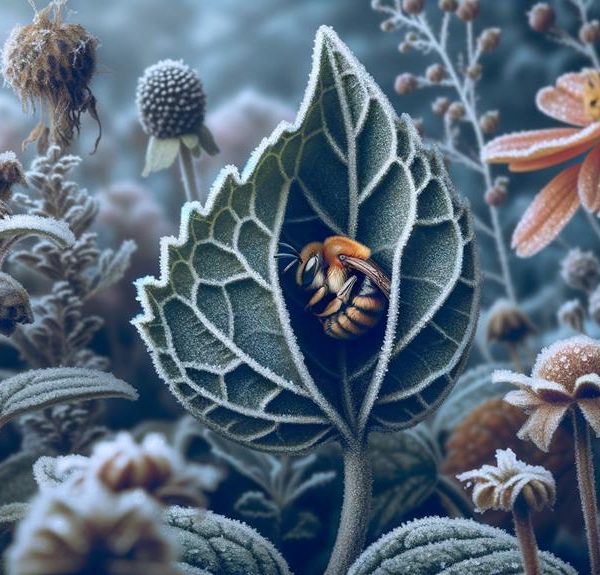Curious about New Zealand's industrious leaf cutter bees and their unique nesting habits? Discover their vital role and the threats they face.
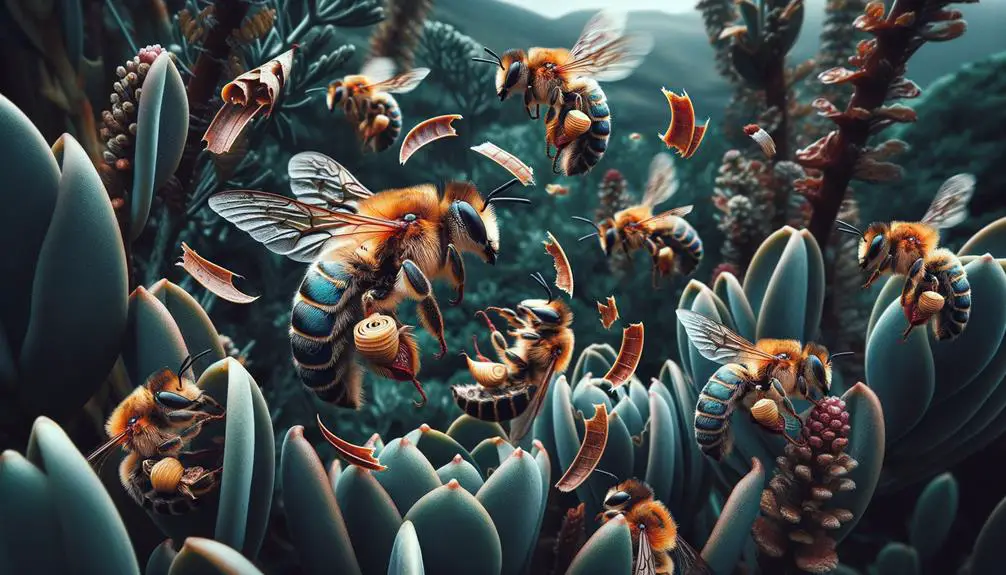
Leaf Cutter Bees Nz Facts
You might think that a bee with a penchant for interior design is the stuff of fairy tales, but it's high time you met New Zealand's leaf cutter bees.
They're not just your run-of-the-mill honey makers; these industrious insects are known for their unique nesting habits, using cut-out leaf segments to line their homes.
You'll find their role in pollination fascinating, but the threats they face are a pressing concern.
Curious to find out more? There's a wealth of intriguing details to uncover.
Key Takeaways
- Leaf cutter bees, also known as Megachile, are solitary creatures that play a crucial role in New Zealand's ecosystem by pollinating a variety of plants.
- These bees construct nests from leaf fragments, carving out individual cells within existing crevices or holes, and line them with compacted leaf fragments for protection.
- Leaf cutter bees carry pollen on their abdomens and transfer it between flowers through their 'belly flopping' technique, ensuring efficient pollination and being less prone to nectar robbing and diseases.
- Threats facing leaf cutter bees in New Zealand include habitat loss, climate change, pesticides, parasitic infections, and loss of genetic diversity, necessitating conservation efforts such as habitat preservation, avoiding harmful pesticides, reporting invasive species, building bee hotels, and supporting research and initiatives.
Understanding Leaf Cutter Bees

While you may be familiar with honeybees, it's time to delve deeper into the world of leaf cutter bees, a remarkable species that plays a crucial role in New Zealand's ecosystem. Scientifically known as Megachile, these industrious insects are a sight to behold. Not only do they pollinate a variety of plants, but they also construct intricate nests from leaf fragments, hence their name.
You'll notice leaf cutter bees by their peculiar behaviour. They're solitary creatures, preferring to work alone rather than in a colony. You'll spot them on warm, sunny days, busily snipping away at leaves with their strong mandibles. Don't worry, though. They're not damaging your plants, but rather gathering materials for their nests.
When it comes to pollination, leaf cutter bees are exceptional. Unlike honeybees who carry pollen on their hind legs, leaf cutters carry it on their abdomen. This difference in pollen placement allows for more effective cross-pollination. Each time a leaf cutter lands on a flower, it's depositing pollen from the previous plant, and picking up new pollen to transfer to the next. This makes them invaluable to New Zealand's biodiversity.
Unique Nesting Habits Explored
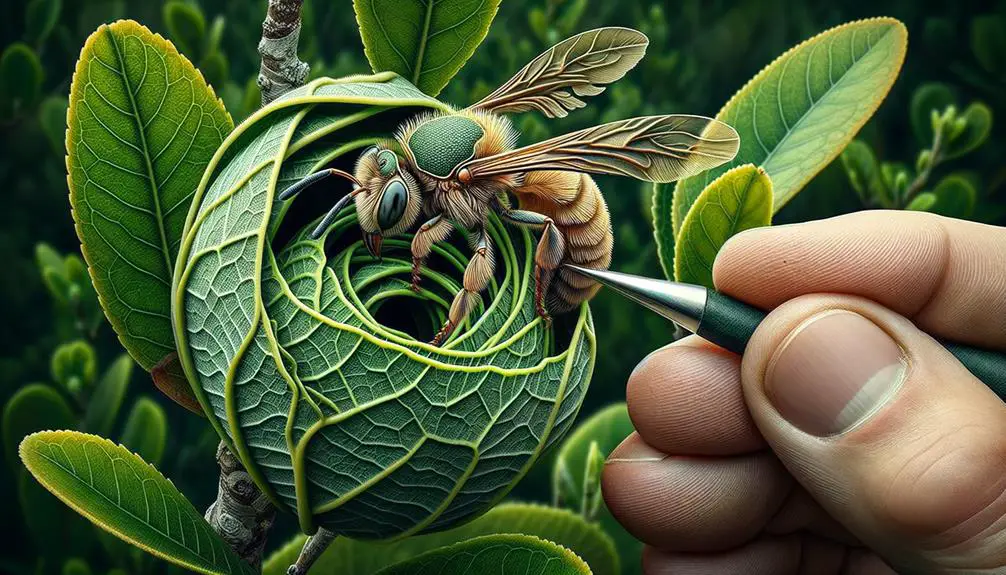
You'll find the nesting habits of leaf cutter bees particularly fascinating, as they meticulously create their abodes using precisely cut leaf fragments. Unlike many bees, which construct hives in large colonies, leaf cutter bees are solitary insects. They prefer to seek out existing crevices or holes, often in dead wood or human-made structures, to establish their nests.
Each leaf cutter bee carves out individual cells within these nests, using their sharp mandibles to snip pieces of leaf. They then carry these leaf fragments back to the nest, where they're skillfully arranged and compacted to form a protective lining. The precision and care taken in this process is indeed remarkable.
Within each cell, the female bee deposits an egg, along with a nourishing provision of pollen and nectar. This substance will feed the developing larva once the egg hatches. The cell is then sealed off with another layer of leaf fragments, providing a safe and secure environment for the growing offspring.
This unique method of nest construction not only reflects the leaf cutter bee's solitary nature but also demonstrates their resourcefulness and adaptability in utilizing available materials. Their nesting habits are a testament to their incredible industriousness and ingenuity.
Leaf Cutter Bees and Pollination
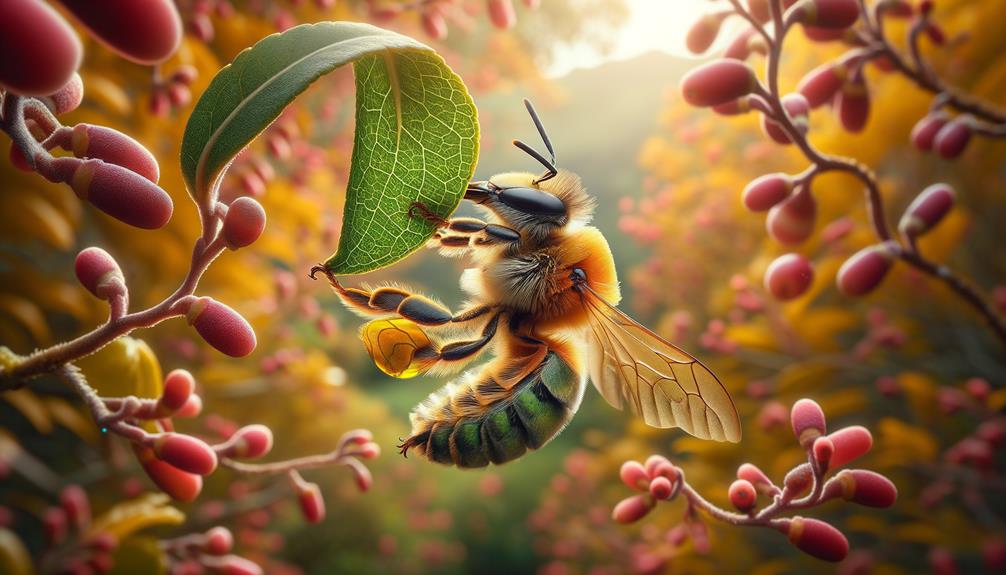
Beyond their renowned architectural prowess, leaf cutter bees also play a pivotal role in pollination, a process critical to the survival of many plant species.
Unlike honeybees, which gather nectar and pollen in specialized pouches, leaf cutter bees carry pollen on their abdomens. When they visit a flower, pollen sticks to the fuzzy hairs on their abdomen and is transferred to the next flower they visit. This method of pollen transport, known as 'belly flopping', is remarkably efficient.
An analysis of leaf cutter bees' role in pollination shows they're superior pollinators for several reasons. Firstly, their unique 'belly flopping' technique ensures a higher transfer rate of pollen between flowers. Secondly, leaf cutter bees are less prone to nectar robbing, a behaviour that often reduces the effectiveness of pollination. Furthermore, leaf cutter bees are solitary and therefore not as affected by diseases that can decimate entire colonies of social bees.
In New Zealand, leaf cutter bees are vital in the pollination of various crops and wild plants. Understanding their behaviour and biology can lead to improved pollination strategies, boosting agricultural productivity and ensuring ecosystem sustainability.
Threats Facing Leaf Cutter Bees

Despite their essential role in pollination, leaf cutter bees face a myriad of threats, from habitat loss to climate change, all of which could potentially disrupt their population and survival. Now, you might be intrigued to know how these threats may impact their existence.
Threat | Impact |
|---|---|
Habitat Loss | The destruction of their natural habitat due to deforestation and urbanisation can lead to a decrease in food sources and nesting sites, ultimately leading to a decline in their population. |
Climate Change | Changes in weather patterns can disrupt the lifecycle of leaf cutter bees. Early springs or late winters can affect their food source availability. |
Pesticides | These chemicals can be lethal to bees, causing significant damage to their population. Even non-lethal doses can affect their ability to reproduce and navigate. |
Parasites | Parasitic infections can weaken bee colonies, making them more susceptible to other threats. |
Conserving NZ's Leaf Cutter Bees
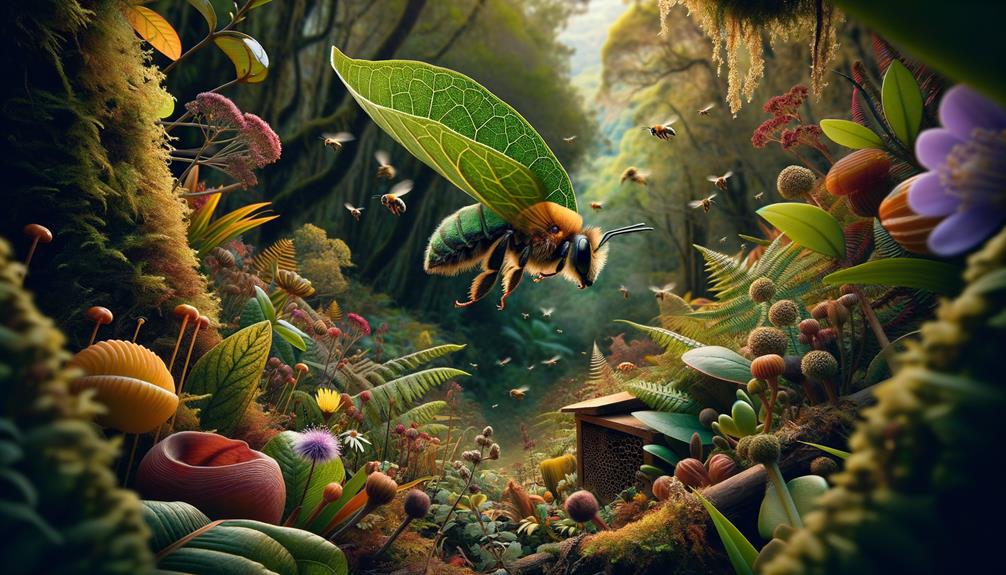
In order to protect and conserve New Zealand's leaf cutter bees, it's crucial to understand and implement effective strategies that combat the threats they face. These threats range from habitat loss and fragmentation to the use of pesticides and the introduction of non-native species.
Firstly, you can engage in habitat preservation by ensuring they've access to diverse native plants. This not only provides them with food but also suitable nesting sites. Actively promote the growth of indigenous vegetation in your garden and discourage the use of harmful pesticides.
Secondly, you can aid in mitigating the threat posed by non-native species. Be vigilant and report any sightings of invasive species that could harm the leaf cutter bees' ecosystem. You can also build bee hotels in your garden, providing safe havens for these beneficial insects.
Lastly, you can support research and initiatives aimed at conserving leaf cutter bees. This could involve participating in citizen science projects or advocating for policies that protect these bees.
Conclusion
So, you've witnessed the fascinating world of NZ's leaf cutter bees. You've learnt about their unique nesting habits, their critical role in pollination, and the looming threats they face.
It's clear these industrious pollinators need our help. As a conscious citizen, you've got the power to make a difference. By actively conserving their habitats and spreading awareness, you're contributing to the survival of these incredible bees.
They're counting on you, and every small action matters.


